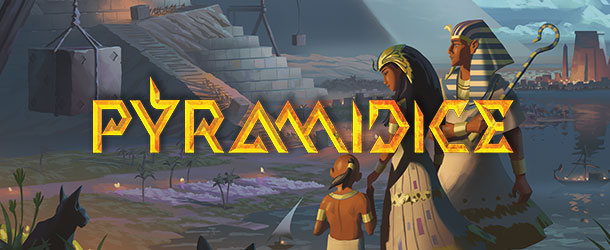Pyramidice, the game of dice and card combos set in Ancient Egypt, focuses on the construction of the Pyramids on the Giza plateau and on the worship of the ancient Gods. Players assume the roles of ancient architects of great Egypt called upon to vie for the Pharaoh's respect through the construction of majestic pyramids. But It is not all about engineering and labor: they will need the favor of the Gods, and choose the right deities to address their prayers to to safeguard their legacy. The game mechanics are tied to the theme, and the setting reveals a great attention to historical details. In this series of articles, we delve into the Gods, the Pyramids, and the Architects featured in the game, with the support of the historical consultant prof. Marco Mengoli, who collaborated with the development team. In the previous article we talked about the Gods, now it’s time to learn more about the Pyramids featured in the game.
The pyramids were funerary edifices and date roughly from the 27th century BC to the 16th century BC. The Pyramids of Giza, the most known, are part of an architectural history of which they are the pinnacle. It all started with the Mastaba, the most widely used tomb in ancient Egypt, which has a very long history and was initially used for the pharaohs as well. The mastaba was a bench-shaped structure with sloping walls and a flat roof, built with sun-dried bricks, and it already had the typical characteristics of Egyptian tombs – a deep shaft and the underground burial chamber.
The first pyramid was built by the pharaoh Djoser, the first king of the 3rd dynasty (c. 2592–c. 2566 BCE) and his minister and architect Imhotep – who is the architect most present in Pyramidice and the hardest to beat in solitaire mode. For the new funerary complex at Ṣaqqārah, outside the royal capital of Memphis, they decided to use a different type of material: limestone. Until that moment stone had been used for millennia in Egypt, but only to make vases and decorations. They knew how to work it very well, but they had never built anything with it.
The construction started as a mastaba built with little limestone bricks - the stone was cut to the size of the sun-dried bricks used until then. When the mastaba was completed, however, they chose to go further, stacking a few mastabas on top of each other. The result was completely different from the previous flat-topped shape: a six-stepped pyramid, looking like a staircase, 62 meters high. It is the first stone building recorded in the history of humanity, and is known as the Step Pyramid of Djoser.
The first king of the 4th dynasty (c. 2543–c. 2436 BCE), Snefru headed a period of further expansion and technical innovation in the construction of pyramids. Instead of the staircase form, the project was to build flat-sided monuments in Dahshūr. The first attempt to make a completely flat-sided pyramid was supposed to be about 130 meters high, with stone blocks larger than those previously used in Saqqara. But at some point, the architects concluded that continuing with the initial angle risked causing the whole construction to collapse – and so they changed it, resulting in the Bent Pyramid, also known as Blunted or Rhomboidal Pyramid,105 meters high.
Another attempt was the reconstruction of the Maydum pyramid, originally a seven-stepped funerary monument probably begun by pharaoh Huni, the last king of the 3rd dynasty (c. 2650–c. 2575). The steps were filled in, and the structure was overlaid with fine Tura limestone, giving it the appearance of a true pyramid. But the outer casing and fill of the pyramid began to collapse, and the work was abandoned. Snefru had another pyramid built, the Red Pyramid, which came out flat-sided and beautiful, 105 meters high.
Next are the pyramids of Giza, three 4th-dynasty (c. 2575–c. 2465 BCE) pyramids erected on a rocky plateau on the west bank of the Nile River, in northern Egypt. Royal tombs built for three different pharaohs, along with their associated pyramid complexes and the Great Sphinx. The northernmost, oldest, and largest pyramid of the group was built for Cheops/Khufu, the second king of the 4th dynasty. Called the Great Pyramid, it’s 138 meters high. Chephren/Khafre is slightly lower, but it's clever because it stands on a rise in the ground, reaching 136 meters. Mykerinos/Menkaure, the smallest, is 66 meters high. Additionally the Giza complex include three smaller stepped pyramids.
The subsequent dynasty would be more interested in the funerary temple than the pyramids. The elements of the pyramids would gradually become less impressive; no longer would as much limestone be used in the pyramids of Giza as the filling would consist of leftover material and only the outer part remain limestone, and eventually it would return to sun-dried bricks. The last pyramids date back to the end of the 16th century.
The history of the Egyptians is especially interesting because it allows one to follow the path of their progress in building: starting to work with this stone, experimenting, studying, testing, and making their mistakes. They came to understand perfectly how much the stone could support, how it worked, to build these amazing monuments, included among the Seven Wonders of the Ancient World – and the only one still lasting. The ancient ruins of the Memphis area, including the Pyramids of Giza, Ṣaqqārah, Dahshūr, Abū Ruwaysh, and Abū Ṣīr, are collectively designated a UNESCO World Heritage site.
Pyramids in Pyramidice
The first prototype of Pyramidice consisted of only one pyramid, the large one, without a proper name. During development, the Ergo Ludo’s team realized that as the number of players varied, the game needed greater scalability, which included having a different number of Stone dice in circulation. When adding a second pyramid, the Giza plateau with its three iconic pyramids immediately came to mind: Cheops, Chephren, and Mykerinos, standing close to each other, each of different size, as if they had already been part of a game millennia ago. It became clear that the setting had to be the Giza plateau and the pyramids had to be three of different sizes. Since the first worked very well with its three levels, the second would have two, and the last, one. From the first test with these changes, the solution worked perfectly, naturally fitting into the game.
Cheops, Chephren, and Mykerinos are featured in Pyramidice as Pyramid boards. All three are used in a 4-player game, Cheops, and Chephren in a 3-player game, and only Cheops for two players or solo mode. Each pyramid board has a construction table at its bottom showing how many workers the player must discard during the construction, according to the value of the Stone dice. On the top, it shows the Fame points corresponding for the dice in each level of the pyramid.
Cheops, or the Great Pyramid, was the tomb of the Cheops, or Khufu, second king of the 4th dynasty (c. 2543–c. 2436 BCE), the son and successor of Snefru. One of the largest buildings ever constructed, the pyramid originally was about 147 meters high, but erosion and the removal of most of the polished limestone casing stones have lowered its height to 138 meters. The base and three sides each measure 230 meters in length, and the pyramid’s sides rise at an angle of 51.87° being accurately oriented to the four cardinal points of the compass. To build the pyramid, approximately 2.3 million blocks of stone were cut, transported, and assembled into a masterpiece of technical skill and engineering ability.
In Pyramidice, the pyramid of Cheops is built on three levels, with 9 stone dice at the base (using the number of Workers shown in the construction table and getting Fame points equal to its value), 4 stone dice on the first level (paying an extra worker and getting 2 extra Fame points), and 1 on the second level (2 extra workers and 4 extra Fame points).
The second of the three Pyramids of Giza was built by Chephren, or Khafre, the son of King Cheops, and it is linked by a causeway to his valley temple, constructed of great monolithic blocks of granite and contained remarkable statues of the king. Near the causeway stands the Great Sphinx, which many consider bearing Chephren’s features. Originally 143 meters high, the Chephren pyramid is now only 136 meters, retaining the outer limestone casing only at its topmost portion, and measures 216 meters on each side.
In Pyramidice, Chephren’s pyramid has only two levels: at the base, players pay an extra worker (but gain 2 extra Fame points) and on the first level, they place only one die, with two extra workers (but gain 4 additional Fame points).
The southernmost and last pyramid to be built was that of Mykerinos, or Menkaure, the fifth king of the 4th dynasty, son of Chephren. Each side measures 109 meters, and the structure’s height was 66 meters - it now stands at 61 meters tall. This pyramid was constructed of limestone and Aswan granite. Although the pyramid and mortuary temple were unfinished at Mykerinos’ death, his successor, Shepseskaf, completed the stonework of the mortuary temple in brick. In Pyramidice, Mykerinos is built with only one die, paying 2 extra workers, and gaining 4 additional Fame points.
Information sources: Britannica, Wikipedia.
* Images via Wikimedia Commons (CC BY 4.0): ©Vyacheslav Argenberg / http://www.vascoplanet.com/, Ivrienen at English Wikipedia, Djehouty, Moh hakem.















